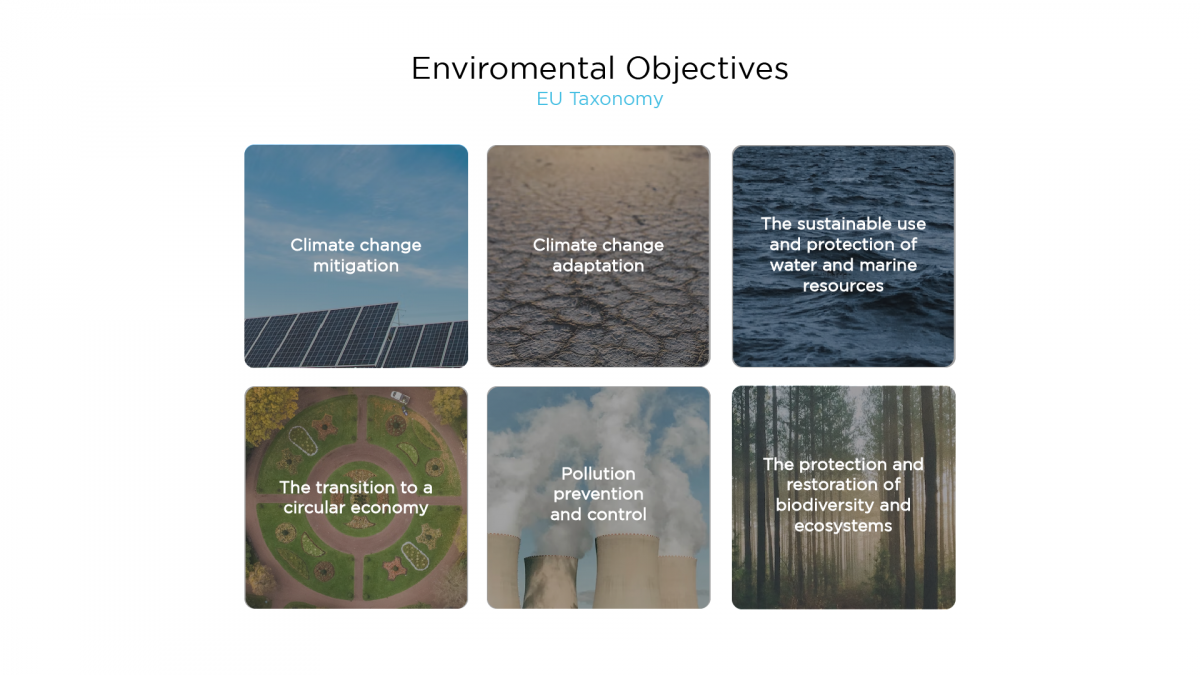EU Taxonom explained
The EU Taxonomy is a classification system for economic activities, to bring clarity to the market regarding which economic activities can be considered sustainable. The EU Taxonomy defines these activities and the related technical standards for six environmental objectives to make finance more sustainable.
Why do we need the EU Taxonomy?
To combat climate change, the EU has agreed on very ambitious objectives for a climate neutral Europe in 2050. It requires a total change of our energy sources and demands larger investments than its Governments can finance. Therefore, the EU introduces a framework and tools which helps the finance sector determine whether an activity is “sustainable” or not. This classification framework shall motivate organizations and countries to redirect money and efforts towards environment-friendly projects.
The EU taxonomy has the following objectives

Objective 1: Climate change mitigation
The first environmental goal is to limit greenhouse gas emissions. In order to counteract climate change and keep the level of emissions in line with the Paris Agreement, an economic activity must avoid or reduce the emission of greenhouse gasses or increase the absorption of greenhouse gasses. Among other things, the following is defined:
7.3.(e) installation, replacement, maintenance and repair of heating, ventilation and air conditioning (HVAC) and water heating systems, including equipment related to district heating services, with highly efficient technologies
7.5. Installation, maintenance and repair of instruments and devices for measuring, regulation and controlling energy performance of buildings.
Source: Delegated Regulation Annex 1 (pdf)
ClevAir helps you reduce CO2 emissions related to ventilation in your commercial real estate
The majority of ClevAir customers experience a reduction of 15-25% of the total energy consumption of the building.
Contact us for an evaluation of whether ClevAir can help you reduce your CO2 emissions related to heat, cooling and Air Conditioning.
Objective 2: Climate change adaptation
The second environmental objective consists of solutions that reduce the risk of the company’s operations being negatively affected by climate or climate change, or that climate change negatively affects people, nature or values.
The specific criteria for environmental objective 2 can be found on the EU’s website: Delegated Regulation Annex 2 (pdf)
With ClevAir, your company will obtain a lower energy consumption, making you less affected by energy scarcity and high energy prices.
Contact us for an assessment of whether ClevAir can help you with energy efficiency.
Objective 3: Sustainable use and protection of water and marine resources
Examples of activities are protection against the harmful effects of discharge of wastewater from industry, during purification, and protecting drinking water from pollution or improving access to drinking water. Other examples are ensuring the sustainable use of marine ecosystems and reducing emissions into the sea.
Objective 4: The transition to a circular economy
Economic activities must be qualified as a significant contributor to the transition to a circular economy. This includes prevention of waste, reuse and recycling, for example efficient use of natural resources in production, reduced use of raw materials or increased use of by-products, and increased lifespan of products.
Objective 5: Pollution prevention and control
Prevention and control consists in protecting the environment against pollution, this can be done, for example, by avoiding emissions, improving air, water or soil quality. Other examples are to prevent health or environmental damage, which may result from the production or use of chemicals.
Objective 6: The protection and reservation of biodiversity and ecosystems
For example sustainable land use, agriculture or forest management.
Whom and EU Taxonomy Timeline?
Companies covered by the Non-Financial Reporting Directive (companies on stock markets with more than 500 employees) have had to report on Climate change mitigation and Climate change adaptation since January 2022.
From January 2023 it will also be mandatory to report on The sustainable use and protection of water and marine resources, The transition to a circular economy, Pollution prevention and control and The protection and restoration of biodiversity and ecosystem.
Companies with more than 250 full time employees are expected to start reporting on their fiscal year of 2023.
Source: https://www.pwc.dk/da/artikler/2022/01/goderaad.html
How can companies benefit from being Taxonomy-aligned?
The EU taxonomy is not only a demand, it also provides possibilities for your company/organization.
- Organizations that align with the EU Taxonomy regulations will be able to attract investors that are looking to fund green projects. Large banks may also be inclined towards funding sustainable economic activities as lower interest rates on loans.
- Climate change advocacy is growing across the world. Becoming Taxonomy-aligned can enhance your company’s reputation and market standing.Let the taxonomy be the starting point of sustainability, apply for certifications and gain competitive advantage.
We wish you all the best luck on your sustainability journey and warm welcome as a ClevAir customer!





Comments
Add Comment